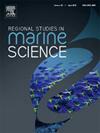Microplastic contamination in Rupsha River of Bangladesh and its impacts on fish species
IF 2.1
4区 环境科学与生态学
Q3 ECOLOGY
引用次数: 0
Abstract
Microplastics have emerged as a significant environmental concern, with their ubiquitous presence and potential adverse impacts on aquatic ecosystems. Microplastics (MPs) are constantly increasing, including aquatic food and aquatic animals. Therefore, this study aimed to assess the extent of microplastic contamination in a segment of Rupsha River, Bangladesh, and its impacts on the fish species that eventually enter the human food cycle. The 18-kilometer stretch of the Rupsha River showed concerning results in the concentration of microplastic ranging from 0.67 ± 0.38 to 8.67 ± 0.38 particles per liter. Microplastics of various shapes, sizes, and colors were detected. Four fish species were tested (Rohu, Mystus, Singhi, Taki) according to the abundance and human consumption, which revealed microplastic ranged from 5.00 ± 0.54 to 7.90 ± 0.95 particles per fish, with Rohu the highest (7.90 ± 0.95 particles per fish) number and Mystus the lowest (5.00 ± 0.54 particles per fish) and 38.61 ± 4.77 to 125.34 ± 13.80 particles per kilogram of fish respectively. These results pointed out a correlation between fish mass and microplastic concentration for pooled samples. Fourier Transform Infrared (FTIR) spectroscopy was used to identify types of microplastic and revealed polypropylene, polyethylene, polyvinyl chloride and nylon. This study highlights the emergence of microplastic hazards in the Khulna Region of Bangladesh, which has a vast resource of rivers and fish.
求助全文
约1分钟内获得全文
求助全文
来源期刊

Regional Studies in Marine Science
Agricultural and Biological Sciences-Ecology, Evolution, Behavior and Systematics
CiteScore
3.90
自引率
4.80%
发文量
336
审稿时长
69 days
期刊介绍:
REGIONAL STUDIES IN MARINE SCIENCE will publish scientifically sound papers on regional aspects of maritime and marine resources in estuaries, coastal zones, continental shelf, the seas and oceans.
 求助内容:
求助内容: 应助结果提醒方式:
应助结果提醒方式:


